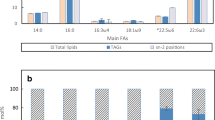Abstract
The ability of Rhizopus chinensis lipase (Thermo 4S-3) to catalyze the deacylation of l,2-diacyl-sn-glycero-3-phosphocholines (sn-1,2-PC) for l-alpha glycerylphosphorylcholine (l-α-GPC) preparation was investigated. Response surface methodology (RSM), based on a modified central composite rotatable design, was employed to examine the effects of substrate concentrations, temperature, enzyme loading, and dosage of CaCl2 on the l-α-GPC yield. RSM analysis indicated good correlation between experimental and predicated values. The optimal condition was confirmed as follows: reaction time, 3.5 h; temperature, 43 °C; enzyme loading, 28.2 U mL−1; substrate concentration, 51.5 mg mL−1; and dosage of CaCl2, 1.9 mg mL−1. Under these conditions, the l-α-GPC yield increased by 96.8%, which was close to the amount predicted by the model.



Similar content being viewed by others
References
Parnetti L (2001) Choline alphoscerate in cognitive decline and in acute cerebrovascular disease: an analysis of published clinical data. Mech Ageing Dev 122:2041–2055
Brownawell AM, Carmines EL, Montesano F (2011) Safety assessment of AGPC as a food ingredient. Food Chem Toxicol 49:1303–1315
De JMMM (2003) Cognitive improvement in mild to moderate Alzheimer’s dementia after treatment with the acetylcholine precursor choline alfoscerate: a multicenter, double-blind, randomized, placebo-controlled trial. Clin Ther 25:178–193
Grimm MOW, Grösgen S, Riemenschneider M, Tanila H, Grimm HS, Hartmann T (2011) From brain to food: analysis of phosphatidylcholins, lyso-phosphatidylcholins and phosphatidylcholin-plasmalogens derivates in Alzheimer’s disease human post mortem brains and mice model via mass spectrometry. J Chromatogr A 1218:7713–7722
Brockerhoff H, Yurkows M (1965) Simplified preparation of l-alpha glycerylphosphorylcholine. Can J Biochem 43:1777–1783
Chen X, Mei Y, Liang P (2009) A process for the preparation of l-α-glyceryl-phosphorylcholine. China Patent CN101544667A
Wang Y, Zhao M, Ou S, Xie L, Tang S (2009) Preparation of a diacylglycerol-enriched soybean oil by phosphalipase A1 catalyzed hydrolysis. J Mol Catal B Enzym 56:165–172
Song YS, Song ES, Kang DS, Song IW, Kang PG, Oh SS, Moon SC, Lee BG (2007) A process for preparation of l-α-glycerylphosphorylcholine. WO 2007145476
Yasuda M, Kiguchi T, Kasahara H, Ogino H, Ishikawa H (2000) Effect of additives on transesterification activity of Rhizopus chinensis lipase. J Biosci Bioeng 90:681–683
He Q, Xu Y, Teng Y, Wang D (2008) Biodiesel production catalyzed by whole-cell lipase from Rhizopus chinensis. Chin J Catal 29:41–46
Ribeiro BD, de Castro AM, Coelh MAZ, Freire DMG (2011) Production and use of lipases in bioenergy: a review from the feedstocks to biodiesel production. Enzym Res. doi:10.4061/2011/615803
Singh AK, Mukhopadhyay M (2011) Overview of Fungal lipase: a review. Appl Biochem Biotechnol. doi:10.1007/s12010-011-9444-3
Franken LPG, Marcon NS, Treichel H, Oliveira D, Freire DMG, Dariva C (2009) Esterification activities of non-commercial lipases after pre-treatment in pressurized propane. Food Bioprocess Technol 3:511–520
Sun SY, Xu Y (2008) Solid-state fermentation for ‘whole-cell synthetic lipase’ production from Rhizopus chinensis and identification of the functional enzyme. Process Biochem 43:219–224
Kwon DY, Rhee JS (1986) A simple and rapid colorimetric method for determination of free fatty acids for lipase assay. J Am Oil Chem Soc 63:89–92
Cochran WG, Cox GM (1992) Experimental designs. Wiley, New York
Blasi F, Cossignani L, Simonetti MS, Brutti M, Ventura F, Damiani P (2006) Enzymatic deacylation of 1,2-diacyl-sn-glycero-3-phosphocholines to sn-glycerol-3-phosphocholine. Enzym Microb Tech 39:1405–1408
Cao W, Zhang C, Hong P, Ji H (2008) Response surface methodology for autolysis parameters optimization of shrimp head and amino acids released during autolysis. Food Chem 109:176–183
Hirashima Y, Farooqui AA, Murphy EJ, Horrocks LA (1990) Purification of plasmalogens using Rhizopus delemar lipase and Naja naja naja phospholipase A2. Lipids 25:344–348
Sigel A, Sige H, Sigel RKO (2007) Metal ions in life sciences. Wiley, New York, p 1912
Radzi SM, Basri M, Salleh AB, Ariff A, Mohammad R, Abdul Rahman MB, Rahman RNZA (2005) High performance enzymatic synthesis of oleyl oleate using immobilised lipase from Candida antarctica. Electron J Biotechnol 8:291–298
Lee DC, Park JH, Kim GJ, Kim HS (1999) Modeling, simulation, and kinetic analysis of a heterogeneous reaction system for the enzymatic conversion of poorly soluble substrate. Biotechnol Bioeng 64:272–283
Guo Z, Sun Y (2007) Solvent-free production of 1,3-diglyceride of CLA: strategy consideration and protocol design. Food Chem 100:1076–1084
Hass MJ, Cichowicz DJ, Phillips J, Moreau R (1993) The hydrolysis of phosphatidylcholine by an immobilized lipase: optimization of hydrolysis in organic solvents. J Am Oil Chem Soc 70:111–117
Acknowledgments
The work is supported by Key Projects in the National Science & Technology Pillar Program during the Twelfth Five-Year Plan Period of China (Contract No: 2011BAD02B04) and Program for New Century Excellent Talents in University (NECT). The authors also thank the Testing & Analysis Center of Jiangnan University.
Author information
Authors and Affiliations
Corresponding authors
Rights and permissions
About this article
Cite this article
Zhang, K., Wang, X. & Liu, Y. Aqueous medium enzymatic preparation of l-alpha glycerylphosphorylcholine optimized by response surface methodology. Eur Food Res Technol 234, 485–491 (2012). https://doi.org/10.1007/s00217-011-1655-x
Received:
Revised:
Accepted:
Published:
Issue Date:
DOI: https://doi.org/10.1007/s00217-011-1655-x



